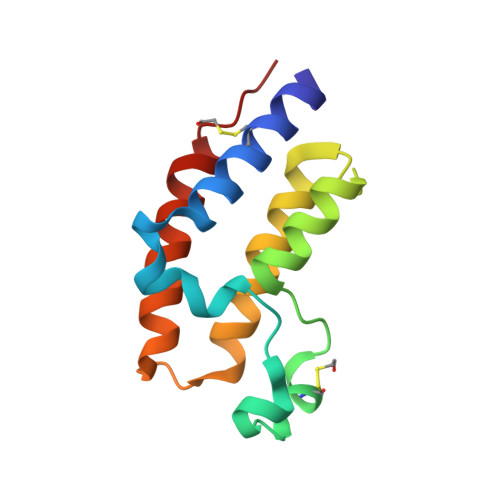Structure-Based Design of gamma-Carboline Analogues as Potent and Specific BET Bromodomain Inhibitors.
Ran, X., Zhao, Y., Liu, L., Bai, L., Yang, C.Y., Zhou, B., Meagher, J.L., Chinnaswamy, K., Stuckey, J.A., Wang, S.(2015) J Med Chem 58: 4927-4939
- PubMed: 26080064
- DOI: https://doi.org/10.1021/acs.jmedchem.5b00613
- Primary Citation of Related Structures:
4Z93 - PubMed Abstract:
Small-molecule inhibitors of bromodomain and extra terminal proteins (BET), including BRD2, BRD3, and BRD4 proteins have therapeutic potential for the treatment of human cancers and other diseases and conditions. In this paper, we report the design, synthesis, and evaluation of γ-carboline-containing compounds as a new class of small-molecule BET inhibitors. The most potent inhibitor (compound 18, RX-37) obtained from this study binds to BET bromodomain proteins (BRD2, BRD3, and BRD4) with Ki values of 3.2-24.7 nM and demonstrates high selectivity over other non-BET bromodomain-containing proteins. Compound 18 potently and selectively inhibits cell growth in human acute leukemia cell lines harboring the rearranged mixed lineage leukemia 1 gene. We have determined a cocrystal structure of 18 in complex with BRD4 BD2 at 1.4 Å resolution, which provides a solid structural basis for the compound's high binding affinity and for its further structure-based optimization. Compound 18 represents a promising lead compound for the development of a new class of therapeutics for the treatment of human cancer and other conditions.
Organizational Affiliation:
†Departments of Medicinal Chemistry, ‡Internal Medicine, §Pharmacology, and ∥Biological Chemistry, ⊥Life Sciences Institute, and #Comprehensive Cancer Center, University of Michigan, Ann Arbor, Michigan 48109, United States.

















